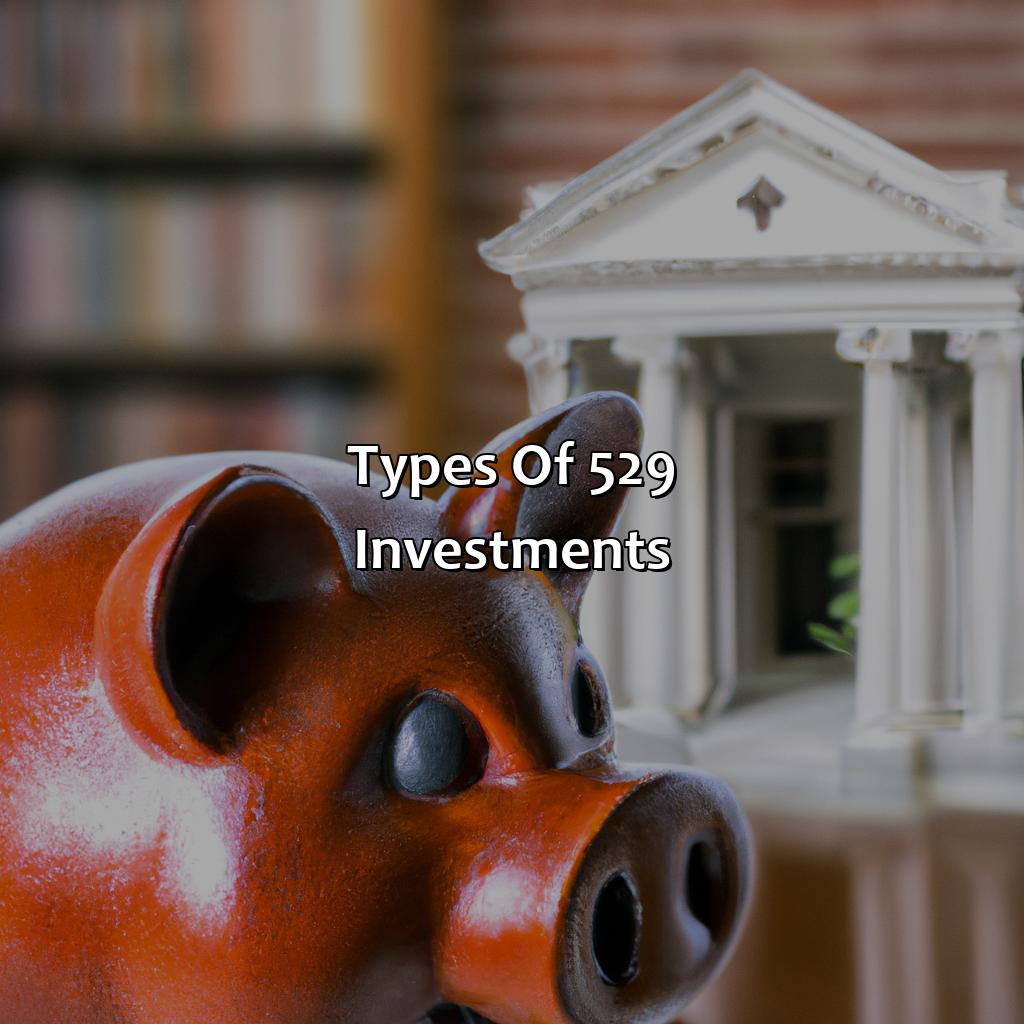What Is A 529 Investment?
Key Takeaway:
- 529 investments are a tax-advantaged savings plan designed to help individuals save for higher education expenses, including tuition, fees, books, and room and board.
- The benefits of 529 investments include tax-deferred growth, tax-free withdrawals for qualified education expenses, and state tax deductions or credits for contributions.
- There are two types of 529 investments: college savings plans and prepaid tuition plans. College savings plans allow for greater investment flexibility, while prepaid tuition plans lock in a specific tuition rate at eligible schools.
Are you looking to invest in your children’s future? With a529 plan, you can do just that. Learn how this unique investment can help you save for your child’s college and beyond. You can start taking advantage of this sound financial decision today.
Understanding 529 Investments
529 Investments – An In-Depth Look at This Higher Education Savings Option
529 investments are a popular savings option for those looking to finance higher education expenses. These investments, named after their tax code that authorizes them, are commonly used to save for tuition, room, board, books, and other expenses.
While not tax-deductible, the earnings on 529 investments grow tax-free as long as they are used for qualified education expenses. This makes them an attractive option for parents, grandparents, and other family members seeking to help finance the costs of higher education.
Investors have a choice between two types of 529 plans: pre-paid tuition plans and education savings plans. A pre-paid tuition plan allows families to lock in today’s tuition rates at eligible public and private colleges and universities, while an education savings plan allows for greater flexibility by investing in a range of mutual funds and other investment options.
One unique feature of 529 investments is that they allow for high contribution limits, with many plans allowing contributions of up to $500,000 over the life of the account. Additionally, the account holder has control over how the funds are invested, with options ranging from conservative to aggressive investment strategies.
To make the most of a 529 investment, it’s important to start saving as early as possible, take advantage of automatic contribution options, and consider the potential tax benefits. With careful planning, a 529 investment can be a powerful tool for financing higher education expenses.

Image credits: retiregenz.com by David Arnold
Benefits of 529 Investments
Fully comprehending the perks of a 529 investment is essential. To dive deeper, let’s look at its Tax Benefits and Investment Growth. Outlining these two topics will give you more knowledge on this investment option’s advantages.

Image credits: retiregenz.com by Adam Woodhock
Tax Benefits
Investing in a 529 plan offers considerable tax advantages. Contributions made are exempt from federal and state taxes, which means that the growth and withdrawals made for qualified education expenses will not be taxed either. This makes 529 investments an attractive option for investing in a child’s future education.
Aside from tax-free growth and withdrawals, some states also offer additional benefits such as state tax deductions or credits for contributions made to a 529 plan. These details vary depending on the state’s requirements and should be researched prior to making any investment decisions.
It is important to note that withdrawals made for non-qualified expenses may be subject to taxes and penalties. However, there are certain exceptions such as death or disability of the beneficiary or receiving a scholarship that may waive these penalties.
Pro Tip: When considering investing in a 529 plan, it is essential to weigh the potential benefits against any potential drawbacks, including limited investment options and potentially high fees. Researching funds offered within the plan and comparing fees across different plans can help make informed investment decisions.
529 investments may not be able to cure your fear of commitment, but they can certainly help your savings grow faster than a Chia Pet on steroids.
Investment Growth
529 Plans can earn compound interest for long-term investment growth. By investing in a diverse range of assets, including stocks, bonds and mutual funds, the potential for high returns is increased while reducing market risks through diversification. This creates an opportunity for the plan’s assets to grow faster than inflation rates, providing greater lifetime benefits for education funding.
Furthermore, Investment Growth can benefit children by building wealth or legacy beyond educational expenses. Unused funds can be transferred between family members so that Investment Growth continues to accrue with the possibility of future educational expenses or other life events where cash reserves may need to be tapped.
One suggestion to maximize Investment Growth would be to get started early when a child is born, giving parents more time for compound interest effects before withdrawing funds for college expenses. Another suggestion includes adjusting investments periodically depending on market conditions and age-based target rebalancing as removing risky investments near graduation might result in less investment growth potential compared to a blindly steady state approach.
529 investments come in all shapes and sizes, kind of like the childhood toys you used to shove under your bed and forget about.
Types of 529 Investments
Do you want to understand the various 529 investment options? Check out the ‘Types of 529 Investments’ section of the article ‘What is a 529 Investment?‘ It has two sub-sections:
- College Savings Plan
- Prepaid Tuition Plan
Find out their unique features and how they can help you with your or your kid’s educational expenses.

Image credits: retiregenz.com by Yuval Washington
College Savings Plan
A Higher Education Investment Strategy is a financial plan for future expenses that can be incurred when pursuing higher learning education. Here are five different types of investment strategies you can consider contributing to secure your child’s educational aspirations:
- Prepaid Tuition Plans – covers the tuition fees and other selected cost expenditures required by the university
- College Savings Plan – an account designed to make college accessible by investing tax-free funds in a flexible manner
- Coverdell ESA – A tax-advantageous savings account intentionally built for raising education expenses for children up to 18 years old
- Investment Trusts – bundling upwards or single stocks into one managed structure, it generates income over a long time frame.
- Savings Bonds – The interest rate is safeguarded by the U.S government, a steady way to help finance your college degree.
Do keep in mind administration costs vary based on State to State and it may have an effect on potential return benefits. Additionally, many programs have restrictions such as enrollment requirements or usage estimation that limit access.
Pro Tip: Remember, before you begin investing, evaluate your current financial status and future plans. Choosing a proper strategy will increase student capacity with little impact on finances.
Lock in today’s tuition rates and pray your kid doesn’t want to major in underwater basket weaving – prepaid tuition plans got you covered!
Prepaid Tuition Plan
A Plan That Guarantees Your Child’s Future Education Expenses
For parents looking to prepay their child’s future college tuition, a guaranteed education plan is the solution. This plan allows you to lock in today’s tuition costs for tomorrow and pay upfront or monthly payments, ensuring your child will receive a quality education.
Below are six essential points to know about guaranteed education plans:
- They may only be used at certain colleges that participate in the program.
- Payments made on these plans can be investment returns as schools typically invest money earned from prepaid plans.
- The guarantee provided by these plans ensures that if investment returns fail to meet expectations, the planning organization assures coverage of remaining costs through other funding sources.
- They are not eligible for tax benefits like qualified tuition programs (QTPs), often referred to as 529 savings plans.
- The cost of the guaranteed education plan varies depending on how old your child is when you purchase it. Usually, prices go up as children get older.
- Giving up on the plan early may lead you being refunded less than what was paid.
It is important to do thorough research before committing to this type of plan as they have limitations and restrictions depending on which state you live in.
Did you know that according to CBS News, some guarantee contracts were severely underfunded during the financial crisis of 2008-2010?
Avoid using your child’s college savings to invest in a ‘how to become a ninja’ course, and instead open a 529 account with ease.
How to Open a 529 Account
To open a 529 account, you must be aware of the steps and factors involved. Qualifying requires meeting the eligibility requirements. After that, choose a plan by examining the options. Finally, decide on investment options to make the most of your money.

Image credits: retiregenz.com by Joel Washington
Eligibility Requirements
529 Plan Eligibility Criteria
To open a 529 account, you must be a US citizen or resident alien. Anyone can contribute to your child’s 529 account regardless of their relationship with the child. There are no income restrictions or age requirements for opening a 529 account.
To be eligible for tax deductions, you should check your state’s rules and regulations regarding 529 plan contributions. Some states provide tax benefits only to residents who invest in their state’s 529 plan, while others offer tax deductions even if you invest in other states’ plans.
It is crucial to keep in mind that your child can only have one 529 account at a time. However, you can change your beneficiary once each year without any taxable penalties.
It is highly recommended to start investing as early as possible to make the most of compounding interest and climb towards achieving your financial goals faster. Moreover, it is advisable to consult with a financial advisor before investing.
Choosing a plan is like picking a lock; you want to find the right combination of fees, investment options, and tax benefits.
Choosing a Plan and Investment Options
When determining your 529 investment plan, it’s essential to consider various options to reap long-term benefits.
- 1. Explore different state 529 plans based on their tax advantages and fees.
- Next, research individual investment options and assess their risk levels and potential returns.
- Finally, compare multiple plans and funds side-by-side to make an informed decision.
Additionally, many plans offer age-based portfolios that adjust investments based on the beneficiary’s age.
It is important to note that selecting the right plan is vital as not all states provide equal benefits.
According to Forbes, “529 college savings plan contributions exceeded $32 billion in 2020.”
Managing and Withdrawing Funds from a 529 Account
Managing and Accessing Funds in a 529 Investment Account
When it comes to managing and accessing your investment funds in a 529 account, there are several key considerations that you should keep in mind. It’s important to understand the specific rules and regulations that govern these accounts, as well as the various options that are available to you for accessing your funds.
One key consideration is that you’ll need to make sure that you’re using your 529 investment funds for qualified education expenses, as defined by the IRS. This includes tuition, fees, books, supplies, and equipment required for enrollment or attendance at eligible institutions.
Another important factor to consider is that different 529 plans may have different rules regarding how you can access your funds. For example, some plans may allow you to make withdrawals at any time for any reason, while others may require you to meet certain eligibility criteria or adhere to a specific timeline for accessing your funds.
If you’re considering investing in a 529 plan, it’s important to carefully review the plan’s terms and conditions to ensure that you fully understand how and when you can access your funds. By doing so, you can help ensure that you’re making the most of your investment while also meeting your education savings goals.
To make the most of your 529 investment, it’s important to stay up-to-date on any changes or updates to the plan’s rules and regulations. By doing so, you can help ensure that you’re maximizing your savings potential and achieving your educational goals. Don’t miss out on this valuable investment opportunity – start investing in a 529 plan today.

Image credits: retiregenz.com by Yuval Washington
Five Facts About 529 Investment:
A 529 investment is a tax-advantaged savings plan for education expenses. (Source: IRS)
529 plans can be used to pay for tuition, books, room and board, and other qualified educational expenses. (Source: Saving For College)
There are two types of 529 plans: prepaid tuition plans and education savings plans. (Source: SEC)
Many states offer a tax deduction or tax credit for contributions to a 529 plan. (Source: NerdWallet)
Grandparents can contribute to a 529 plan for their grandchildren without incurring gift taxes. (Source: Forbes)
FAQs about What Is A 529 Investment?
What is a 529 investment?
A 529 investment is a tax-advantaged savings plan designed to encourage saving for future education costs. It is named after Section 529 of the Internal Revenue Code, which established these savings plans in 1996.
What expenses can be covered by a 529 investment?
A 529 investment can be used to cover many qualified education expenses, including tuition, fees, books, supplies, and room and board. It can also be used to pay for K-12 expenses up to $10,000 per year.
Who can open a 529 investment?
Anyone can open a 529 investment, regardless of income level. Parents, grandparents, relatives, and even friends can open an account for a beneficiary. Some states even offer tax incentives for residents who contribute to a 529 plan.
What happens if the beneficiary does not use all the money in a 529 investment?
If the beneficiary does not use all the money in a 529 investment, the account owner can change the beneficiary to another person who is a family member of the original beneficiary. The account owner can also use the money for their own education or withdraw the funds, but the earnings portion of the withdrawal will be subject to income tax and a 10% penalty.
Can a 529 investment be used to pay for education outside of the United States?
Yes, a 529 investment can be used to pay for qualified education expenses at eligible institutions outside of the United States. However, some restrictions may apply, and the account owner should check with their plan provider to determine what expenses are eligible.
Can a beneficiary have more than one 529 investment account?
Yes, a beneficiary can have multiple 529 investment accounts, but the total amount of contributions cannot exceed the maximum contribution limit set by the plan. Furthermore, it is important to note that contributions made to multiple accounts for the same beneficiary cannot be pooled together to exceed the maximum contribution limit.
 Checkout this IRS Loophole
Checkout this IRS Loophole 
